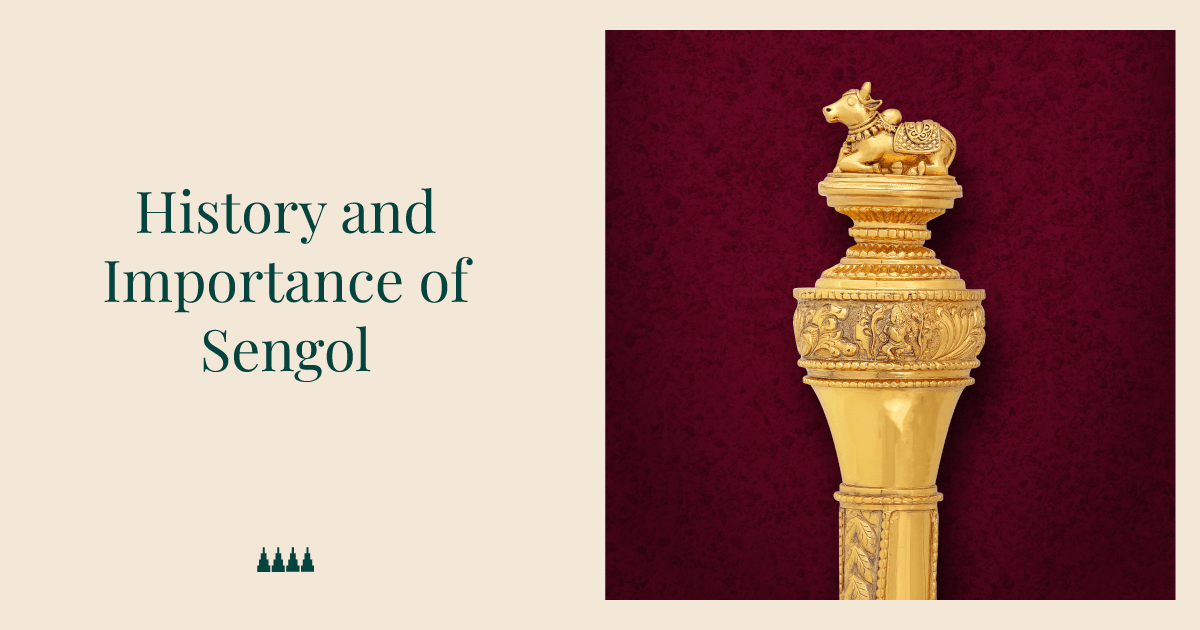Recently, there has been a lot of discussion about Sengol, and it has become the centre of attention. If you want to know the reason, as well as its importance and its history, keep reading till the end of this blog.
Introduction
Sengol is a sceptre used throughout India’s rich history for coronations and other important traditions. It’s intricate design and deep cultural significance make it an essential part of Indian heritage. In this blog, we’ll delve into the origins of Sengol, its meaning, as well as its use today and its importance in modern-day politics.
What is Sengol?
Sengol is a symbolic sceptre that holds great significance in Indian history and culture. It is a beautifully crafted golden sceptre made by Vummidi Ethiraju of the Vummidi Bangaru Chetty family, using over 100 sovereigns of gold. The design of the Sengol is inspired by the traditional Tamil sceptre and is associated with the mighty Chola dynasty.
The Sengol is a powerful symbol portraying India’s history, culture, and ideals of justice and good governance. The Sengol represents the transfer of power and the duty of a ruler to govern with justice and fairness. It symbolises the orderly succession of kings and the importance of good governance.
History of Sengol
Sengol is a traditional Indian symbol which has been around for centuries. The Sengol holds a significant place in India’s history and symbolises the transfer of power and authority. Its history dates back to the Chola dynasty, a prominent ruling dynasty in the Indian subcontinent. The Sengol was inspired by the traditional Tamil sceptre used by the mighty Chola kings to signify the orderly succession of power.
In 1947, during India’s struggle for independence, Lord Mountbatten sought guidance from Pandit Jawaharlal Nehru, India’s first Prime Minister, regarding the symbolic transfer of power. Pandit Nehru, in turn, consulted Shri C. Rajagopalachari, who explored India’s rich history and civilisation and found inspiration in the Chola kings and their traditions.
To symbolise the transfer of power, the Sengol was crafted and presented to Pandit Nehru on August 14, 1947. This historic event marked the formal transfer of power from the British to the Indian government and the beginning of India’s journey as an independent nation.
For many years, the Sengol remained hidden from public view and was kept in the Nehru Gallery of the Allahabad Museum in Prayagraj, India. However, in recent times, its significance was rediscovered, and efforts were made to restore and install it in the new Parliament building, Naya Sansad Bhavan.
Importance of Sengol
The Sengol holds immense importance and significance in India’s history and culture. As a symbol of power, justice, and cultural heritage, it represents the ideals that guide a nation. The Sengol’s significance lies in its political, historical, and cultural dimensions.
1. Political Importance:
- The Sengol represents the formal transfer of power from the British to the Indian government.
- The recent installation of Sengol in the new Parliament building solidifies its significance as a symbol of power and governance.
2. Historical Importance:
-
- The Sengol draws inspiration from the traditional Tamil sceptre used by the mighty Chola kings.
- The Sengol symbolises the orderly succession of kings and the importance of fair and just governance.
3. Cultural Importance:
- The Sengol embodies three significant elements: justice, represented by the statue of Nandi; wealth and prosperity, symbolised by the image of Goddess Lakshmi; and growth and fertility, depicted by the image of Kodimaram.
These elements reflect India’s profound cultural heritage and timeless traditions, reminding us of the country’s ancient values. The restoration and installation of the Sengol in the new Parliament building also signify the importance of preserving and showcasing India’s rich cultural heritage. It serves as a constant reminder to govern with fairness, uphold justice, and promote the values that have shaped India’s identity.
VBJ’s Contribution To Preserving India’s Cultural Heritage
Vummidi Bangaru Jewellers is a renowned jewellery store based in Chennai, India, known for our commitment to preserving India’s cultural heritage through exquisite craftsmanship. Established in 1900, we have gained a reputation for our elegant and magnificent jewellery creations.
As a family-owned business, Vummidi Bangaru Jewellers has been passed down through generations, contributing to our long-standing presence in the jewellery industry. With a focus on South Indian culture, we take pride in showcasing the rich traditions and artistry of the region.
Vummidi Ethiraju of the Vummidi Bangaru Chetty family had the privilege of crafting the remarkable Sengol. Made of over 100 sovereigns of gold, the Sengol symbolises the values of justice, good governance, and peace. This exquisite piece was commissioned by Thiruvavaduthurai Adheenam in Tamil Nadu and entrusted to Pandit Jawaharlal Nehru, India’s first Prime Minister, in 1947.
After being kept in the Nehru Gallery of the Allahabad Museum in Prayagraj, India, for many years, the Sengol is now restored, and installed in the new Parliament building, Naya Sansad Bhavan, on May 28, 2023. This marks a significant moment in Indian history and cultural preservation.
VBJ’s contribution to the creation and restoration of the Sengol showcases our commitment to quality, craftsmanship, and our role in preserving India’s rich cultural heritage. Through our meticulous work, we continue to be a symbol of elegance and tradition in the jewellery industry.
Summing Up
The Sengol holds immense historical, cultural, and political importance in India. It represents the transfer of power and the ideals of justice and good governance. Inspired by the traditional Tamil sceptre of the Chola dynasty, the Sengol symbolises the orderly succession of kings and the importance of fair and just governance.
The Sengol played a pivotal role in India’s journey to independence, as it was presented to Pandit Jawaharlal Nehru during the formal transfer of power from the British to the Indian government in 1947. It remained hidden from public view for many years until its recent restoration and installation in the new Parliament building.
The Sengol’s importance extends beyond politics. It embodies three significant cultural elements: justice, wealth and prosperity, and growth and fertility. These elements reflect India’s rich cultural heritage and timeless traditions, reminding us of the country’s ancient values.
Our long-standing commitment to preserving India’s cultural heritage played a significant role in creating and restoring the Sengol. Our craftsmanship and dedication showcased the elegance and tradition associated with the jewellery industry.
 Store Locator
Store Locator 







0 Comments